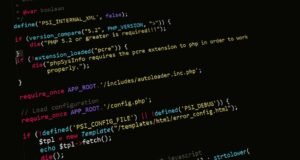Intro: In the ever-evolving tech industry, the terms “applications” and “software” are often used interchangeably. However, there are distinct differences between the two that are important to understand. In this article, we will delve into the definitions of applications and software, discuss their characteristics, and explore their various uses.
Applications and software are both computer programs, but they serve different purposes and have different functionalities. **Applications** are specific programs designed for end-users to perform specific tasks, while **software** refers to a collection of programs, data, and instructions that enable a computer system to perform various functions.
Key Takeaways:
– Applications are programs designed for end-users to perform specific tasks.
– Software refers to a collection of programs, data, and instructions that enable a computer system to perform various functions.
Applications are typically designed to be user-friendly, with intuitive interfaces and tailored functionalities. They are meant to be used by non-technical individuals and often require little to no programming knowledge. *For instance, mobile applications have become an integral part of our lives, allowing us to do everything from ordering food to tracking our fitness goals.*
On the other hand, software is often more complex and versatile, requiring programming skills to develop and maintain. It can be divided into two categories: system software and application software. *System software, such as operating systems and device drivers, manage the hardware and provide a platform for running application software.* Meanwhile, *application software, including word processors, graphic design programs, and accounting software, aim to meet specific user needs.*
Let’s take a closer look at some distinguishing features of applications and software:
Table 1: Applications vs. Software Comparison
| | Applications | Software |
|———|————–|———————-|
| Purpose | Perform | Enable various |
| | specific | computer functions |
| | tasks | |
| Usage | End-user | Developers, IT |
| | focused | professionals |
| Examples| Mobile | Operating systems, |
| | applications | word processors |
While applications are usually developed for a specific operating system or platform, software can be built to run on various platforms, such as Windows, macOS, or Linux. This versatility allows for wider adoption and availability across different devices. *For example, popular software like Adobe Photoshop is available for both Windows and macOS, catering to a broader user base.*
Table 2: Software Platform Compatibility
| | Platform-specific | Cross-platform |
|———–|———————————-|———————————-|
| Examples | iOS applications, | Adobe Photoshop, |
| | Windows applications, | Google Chrome |
| | Android applications | |
Another aspect that sets applications apart from software is the mode of delivery. Applications are typically delivered through app stores or websites and can be easily installed or uninstalled by the user. On the contrary, software is typically purchased or downloaded directly from the developer’s website and often requires installation and configuration. *This makes applications more accessible and user-friendly for the average person, while software may require a higher level of technical expertise.*
Table 3: Delivery Methods
| | Applications | Software |
|————-|—————————-|——————————–|
| Delivery | App stores, | Purchase/download |
| Method | websites | directly from the developer |
| Installation| Easy to install and | Requires installation and |
| Process | uninstall | configuration |
In essence, while applications and software are both computer programs, they differ in their target audience, complexity, purpose, and delivery methods. **Applications** cater to end-users, providing specific functionalities through intuitive interfaces, while **software** encompasses a broader range of programs, enabling various computer functions.
By understanding the distinctions between applications and software, you can make more informed decisions when selecting the right tools for your needs, whether it’s finding a specific application for a task or choosing software that enhances your computer’s capabilities. So next time you hear these terms thrown around, you’ll know exactly what they mean.

Common Misconceptions
Misconception #1: Applications and Software are the Same Thing
One common misconception is that applications and software are interchangeable terms. However, there is a distinction between the two.
- Applications refer to specific programs or tools that perform specific tasks on electronic devices.
- Software is a broader term that encompasses all types of computer programs, including applications.
- While all applications are software, not all software can be categorized as applications.
Misconception #2: Applications Only Run on Mobile Devices
Another misconception surrounding applications is that they are exclusively designed for mobile devices.
- Applications can run on various platforms, including desktop computers, laptops, tablets, and even wearable devices.
- There are different types of applications for different platforms, such as desktop applications, web applications, and mobile applications.
- Each platform has its own app store or marketplace from where users can download and install applications.
Misconception #3: Software is Always Developed by Large Companies
Some people believe that software is exclusively developed by large corporations or tech giants.
- Software development is a vast field involving individuals, small businesses, and startups as well.
- There are many independent software developers who create and distribute their own software applications.
- Open-source software is developed collaboratively by a community of volunteers, rather than a single corporation.
Misconception #4: Applications Can Only Be Obtained by Purchasing
Another misconception is that applications can only be obtained by purchasing them.
- While some applications are paid, there are also numerous free applications available for download.
- Many applications follow a freemium model, offering basic features for free and additional premium features for a fee.
- Open-source applications are freely available for users to download, modify, and redistribute without any cost.
Misconception #5: Applications Are Always Safe and Secure
One dangerous misconception is assuming that all applications are safe and secure to use.
- Not all applications go through rigorous security testing, making them vulnerable to various threats.
- Some malicious applications may contain malware, viruses, or other harmful elements.
- It is important to only download applications from trusted sources and regularly update them to mitigate security risks.

Applications Leaderboard
Here is a ranking of the top applications used across different platforms.
| Platform | Most Popular Application | No. of Downloads (in millions) |
|---|---|---|
| iOS | 500 | |
| Android | 1000 | |
| Windows | Microsoft Office | 750 |
Software Sales by Category
Explore the distribution of software sales according to different categories.
| Category | Revenue (in billions) |
|---|---|
| Productivity | 25 |
| Gaming | 60 |
| Entertainment | 10 |
Applications by Age Group
Discover the most popular applications among different age groups.
| Age Group | Most Popular Application | Percentage of Users |
|---|---|---|
| 13-18 | TikTok | 35% |
| 19-30 | 45% | |
| 31-45 | 40% |
Software Utilization by Industry
See how different industries utilize software solutions in their operations.
| Industry | Adoption Rate |
|---|---|
| Healthcare | 85% |
| E-commerce | 70% |
| Finance | 90% |
Applications Market Share
Examine the market share of different application platforms.
| Platform | Market Share |
|---|---|
| iOS | 30% |
| Android | 65% |
| Windows | 5% |
Software Security Vulnerabilities
Discover the count of security vulnerabilities found in various software types.
| Software Type | No. of Vulnerabilities |
|---|---|
| Operating Systems | 1200 |
| Web Browsers | 800 |
| Office Suites | 500 |
Applications by User Rating
Explore applications based on their user ratings.
| Application Name | Rating (out of 5) |
| 4.5 | |
| Netflix | 4.8 |
| Spotify | 4.3 |
Software Development Cost
Discover the average cost to develop different types of software.
| Software Type | Cost (in millions) |
|---|---|
| Mobile Application | 2.5 |
| Enterprise Software | 10 |
| Video Games | 20 |
Applications Revenue by Monetization Model
Explore how applications generate revenue through various models.
| Monetization Model | Revenue (in billions) |
|---|---|
| In-App Purchases | 50 |
| Advertising | 30 |
| Subscriptions | 20 |
Conclusion
In today’s digital era, applications and software play a fundamental role in our everyday lives and across various industries. The tables presented above highlight intriguing insights, including the popularity of applications across different age groups, the distribution of software sales, market share of application platforms, and more. Furthermore, we explored software vulnerabilities, user ratings, development costs, and revenue generation models. These tables reflect the diverse and dynamic landscape of applications and software, emphasizing their significance in the modern world.
Frequently Asked Questions
What are applications and software?
Applications and software refer to computer programs designed to perform specific tasks or functions. They are both tools that enable users to interact with a computer or a mobile device.
What is the difference between applications and software?
While applications are a specific type of software, the main difference lies in their purpose. Applications are usually designed for end-users and are focused on meeting specific needs, whereas software is a broader term that encompasses all types of programs, including operating systems and frameworks.
Can software be considered an application?
Yes, certain types of software, such as productivity suites or graphic design tools, can be considered applications. However, not all software is necessarily an application, as software can also include system-level programs or development libraries.
What are some examples of applications and software?
Examples of applications include web browsers (e.g., Google Chrome), messaging apps (e.g., WhatsApp), and video editing programs (e.g., Adobe Premiere Pro). Software examples include operating systems (e.g., Microsoft Windows), programming languages (e.g., Python), and databases (e.g., MySQL).
How are applications and software developed?
Applications and software are typically developed using programming languages, frameworks, and development tools. Developers write code to create the functionality and user interface of an application or software. The development process often involves designing, coding, testing, and debugging.
How are applications and software installed?
Applications are commonly installed on devices through app stores, such as the Apple App Store or Google Play Store. Software installations vary depending on the type, but often involve downloading an installer file and following installation steps provided by the software provider.
Can applications and software be updated?
Yes, both applications and software can be updated. Updates may include bug fixes, performance improvements, new features, or security patches. Applications often provide automatic update options, while software updates may be obtained through official websites or software update tools.
Are applications only available on mobile devices?
No, while applications are widely associated with mobile devices, they can also be developed and used on desktop computers, laptops, and other devices. Mobile applications, however, tend to have specific optimizations for touch-based interfaces and smaller screens.
Can software be used without an internet connection?
Yes, many software programs can be used without an internet connection. However, certain features or functionalities of the software may require internet connectivity, such as web-based services or cloud storage options.
How are applications and software licensed?
Applications and software are typically licensed to users based on specific terms and conditions defined by the software provider. Licensing models may include free and open-source options, one-time purchase licenses, or subscription-based models.





